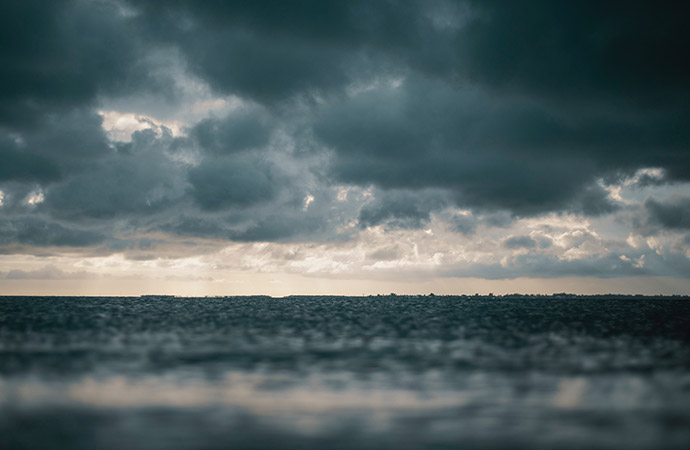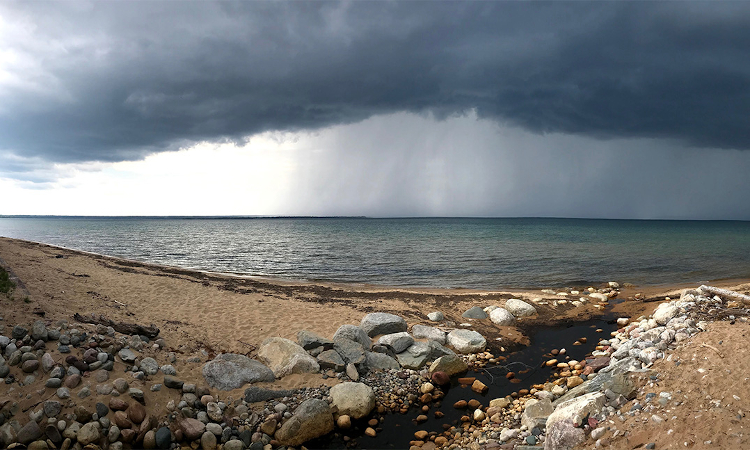Lake Temperatures in the Time of Climate Change
Press release written by the University of Vermont
Reference
Doubek JP, Anneville O, Dur G, Lewandowska AM, Patil VP, Rusak JA, Salmaso N, Seltmann CT, Straile D, Urrutia-Cordero P, Venail P, Adrian R, Alfonso MB, DeGasperi CL, de Eyto E, Feuchtmayr H, Gaiser EE, Girdner SF, Graham JL, Grossart H-P, Hejzlar J, Jacquet S, Kirillin G, Llames ME, Matsuzaki SS, Nodine ER, Piccolo MC, Pierson DC, Rimmer A, Rudstam LG, Sadro S, Swain HM, Thackeray SJ, Thiery W, Verburg P, Zohary T & Stockwell JD (2021) The extent and variability of storm-induced temperature changes in lakes measured with long-term and high-frequency data. Limnology and Oceanography, 66, 1979–1992. doi: 10.1002/lno.11739.

People depend on lakes for many ecosystem services such as water, food, transportation, and recreation, but these services are at an unknown level of risk because we do not understand how lakes are affected by climate change. A network of 39 scientists from 20 countries on five continents are collaborating to put long-term and high-frequency data to work to understand, predict, and communicate the role and response of lakes in our changing global environment. This work was partly funded by the John Wesley Powell from U.S. Geological Survey and the Foundation for Research on Biodiversity (FRB), through the research projects GEISHA of the FRB’s Center for Biodiversity Synthesis and Analysis (CESAB).
Many of the scientists hypothesized that storms would have strong impacts on water temperature and water column mixing, based on a prior synthesis study. However, the team’s most recent study found that wind- and rainstorms do not cause major temperature changes in lakes.
They examined how wind- and rainstorms affected lake temperature across 18 lakes and 11 countries using meteorological and water column temperature data and found minimal changes to lake temperature from storms. In fact, they found that day-to-day changes in lake temperature during non-storm periods were often more extreme than storm-induced temperature changes. As expected, storms impacted the temperature of deep lakes less than shallow lakes because more energy is needed to mix layers of water with different temperatures in deep lakes than in shallow lakes. For example, storm-induced temperature changes in Lake Superior (average depth almost 500 feet) will be smaller than in Lake Okeechobee (average depth about 10 feet).

A storm rolls over Lake Superior. Photo credit: Jessica Wesolek, Lake Superior State University’s Center for Freshwater Research and Education
“Because storm-induced changes to lake temperature were minimal overall, storm-induced changes in other environmental conditions such as nutrient concentrations or light may have larger impacts on lake animals and plants,” said Jonathan Doubek, Assistant Professor at Lake Superior State University in the School of Natural Resources & Environment and the Center for Freshwater Research and Education, who joined the network while at the University of Vermont. These findings represent concrete progress in understanding how lakes are weathering storms.
“Professor Doubek’s study highlights the usefulness of high-frequency data: we were able to discover that the effect of storms on lake temperatures may not be as strong as we previously believed,” said Dr. Jason Stockwell, Professor and Director of the Rubenstein Ecosystem Science Laboratory at the University of Vermont.
The team of scientists has begun analyzing the impact of storm-related changes in nutrient concentrations and light availability on organisms using the same global dataset and has recently had a proposal funded to help continue this work into the future. “The power of global collaborative teamwork to pool data and ideas is improving our understanding about how our planet functions and may function in the future,” Stockwell said. “We need this information to protect ecosystem and human health.”
With the major crisis facing biodiversity, the need to synthesize scientific data in ecology has never been greater. When pooled, these existing data can be used to address new issues, significantly advance knowledge and provide recommendations for decision-makers. Since it was created in 2010, the Centre for the Synthesis and Analysis of Biodiversity (CESAB) has been collecting and pooling existing data sets in the field of biodiversity and developing complex statistical methods to assess the state of biodiversity and model its future.
More information about the working group GEISHA.
FRB-CESAB, John Wesley Powell Center (U.S. Geological Survey), Vermont Water Resources and Lake Studies Center de l’université de Vermont, U.S. National Science Foundation, Fulbright Award (U.S. Department of State et Commission Franco-Américaine), Université Savoie Mont Blanc, NERC-funded GloboLakes Project, MANTEL project, Swedish Research Council, BEYOND 2020 project.
University of Vermont (USA), Inrae (France), Université Savoie Mont Blanc (France), Shizuoka University (Japon), University of Helsinki (Finlande), US Geological Survey (USA), Ontario Ministry of Environment, Conservation and Parks (Canada), Queen’s University (Canada), Fondazione Edmund Mach (Italie), Competence Center for Wood and Forestry (Allemagne), University of Konstanz (Allemagne), Uppsala University (Suède), Helmholtz Institute for Functional Marine Biodiversity (Allemagne), University Oldenburg (Allemagne), Universidad de Ingeniería y Tecnología (Pérou), Leibniz Institute of Freshwater Ecology and Inland Fisheries (Allemagne), Freie Universität Berlin (Allemagne), Universidad Nacional del Sur (Argentine), King County Water & Land Resources Division (USA), Marine Institute Newport (Irlande), Center for Ecology and Hydrology (UK), Florida International University (USA), Crater Lake National Park (USA), Potsdam University (Allemagne), Institute of Hydrobiology (République Tchèque), Instituto Tecnológico Chascomús (Argentine), Center for Environmental Biology and Ecosystem Studies (Japon), Rollins College (USA).